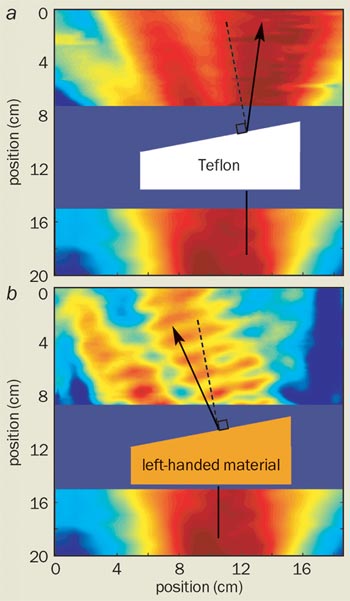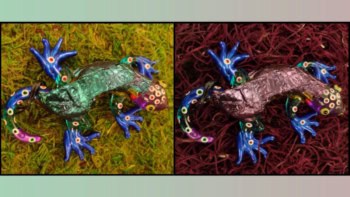Recent experiments that demonstrate the negative refraction of light could bring a heated scientific debate to a close, and give negative-index materials a positive future

One of the most fundamental phenomena in optics is refraction. When a beam of light crosses the interface between two different materials, its path is altered depending on the difference in the refractive indices of the materials. The greater the difference, the greater the refraction of the beam. For all known naturally occurring materials the refractive index assumes only positive values. But does this have to be the case?
In 1967 Soviet physicist Victor Veselago hypothesized that a material with a negative refractive index could exist without violating any of the laws of physics. Veselago predicted that this remarkable material would exhibit a wide variety of new optical phenomena, from reversed geometrical optics to reversed Doppler shifts. However, until recently no one had found such a material, and Veselago’s ideas had remained untested.
In the last three years all this has changed, and negative-index materials are at the centre of a lively – and sometimes heated – debate (see “Electromagnetic materials enter the negative age”Physics World September 2001 pp47-51; and August 2002 pp8-9). In 2000, following insights from John Pendry and co-workers at Imperial College in London, our group at the University of California in San Diego used combinations of copper rings and wires that were deposited on circuit-board substrates to create materials that had unusual electromagnetic properties. We were convinced that one of these “metamaterials” had a negative refractive index, and in 2001 we performed an experiment that confirmed that a microwave beam would undergo negative refraction at the interface between our metamaterial and air – unlike any existing material.
The possibility that materials – albeit artificially constructed ones – could reverse the refraction of light at an interface sparked a flurry of speculation about the new phenomenon, and about the applications it might enable. One of the more provocative suggestions came from Pendry, who predicted that a slab of negative-index material could refocus the rays of a nearby source far better than the diffraction limit that is associated with all positive-index optics. In other words, it could lead to a “perfect lens”. But despite our experimental results, many researchers found the concept of negative refraction and its consequences unsettling. Was there a flaw in the reasoning? Could the experimental results be otherwise explained?
Negative reaction
In his original analysis Veselago pointed out that while nature allows for negative refractive indices, they can only occur in a dispersive medium – a material in which beams of light with different wavelengths are refracted in different directions. In 2001 Prashant Valanju and colleagues at the University of Texas suggested that dispersion would be the downfall of negative refraction.
Valanju agreed that a beam consisting of a single wavelength could indeed be refracted in the negative direction, but noted that real light waves always have more than one wavelength component. This means that refraction at the interface between a positive-index material and a negative-index material would tear the wave apart, leaving no single negatively refracted wave. Valanju reasoned that the refracted wave would die away and that any practical realization of negative refraction, such as Pendry’s perfect lens, was therefore impossible.
As for the experimental evidence, Valanju criticized the proximity of the detector to the sample, claiming that the observed fields were due to the rapidly decaying, multiwavelength inhomogeneous wave. He suggested that if we were to measure the inhomogeneous wave further away from the sample then we would no longer be able to detect the fields.
All materials are dispersive to some degree. The focal length of a lens, for example, varies depending on the colour of light that is being focused. But the negative-index metamaterials that have been demonstrated are far more dispersive than typical materials. Does this inherent dispersion constitute proof that negative refraction is impossible?
Negative refraction
Two experiments have just been performed that could finally lay the issue of negative refraction to rest. They support our original findings and uphold Veselago’s hypothesis. Using a planar waveguide configuration, Andrew Houck and colleagues at the Massachusetts Institute of Technology (MIT) have mapped the field pattern of microwaves that were transmitted through wedge-shaped samples of both positive- and negative-index materials (Phys. Rev. Lett. 90 137401).
The researchers used a positive-index Teflon wedge as a control sample, which caused the path of a microwave beam to exit the sample at a positive angle with respect to a line drawn perpendicular to the surface, in accordance with Snell’s law. In contrast, the beam that emerged from a metamaterial wedge that was made from a grid of rings and wires exited at a negative angle for certain frequencies. In other words, the beam was negatively refracted (figure 1).

To make sure that the observed beam was due to the inherent negative index of the wedge – as opposed to an artefact associated with the sample being lossy or diffractive – the team used two different wedge samples so that waves would be incident on the metamaterial at two different angles. Both cases exhibited negative refraction at angles that were consistent with the sample having a well defined negative index – confirmation of Snell’s law for a negative refractive index. In case there were still doubters, the researchers went further to show that a rectangular sample of the metamaterial can refocus the rays from a nearby antenna – verifying another of Veselago’s many predictions.
Using a different approach, Claudio Parazzoli, Kin Li and co-workers in the Phantom Works division of Boeing constructed a wedge sample that was appropriate for free-space measurements (figure 2). Again based on a ring and wire structure, the Boeing sample clearly demonstrates negative refraction (Phys. Rev. Lett. 90 107401). As in the MIT experiment, the negatively refracted beam does not decay as a function of distance in any anomalous manner, even when it was measured as far as 28 wavelengths – about 66 cm – from the sample. The Boeing group also calculated the refractive index of the metamaterial using electromagnetic simulations. The value obtained showed excellent agreement with the refraction data, and has the same variation as a function of frequency as the experimentally measured index.
Positive implications
These experiments should be sufficient to dispel any doubts regarding the reality of negative refraction. But there are additional problems in realizing the exotic applications that have been predicted for negative-index materials. Because it is desirable to convey as much power as possible through a negative-index material for device applications, absorption must be minimized. The metamaterial samples that were used in the recent refraction experiments tend to have significant losses, and this could be an intrinsic property of negative-index materials
There is strong theoretical evidence, however, that negative refraction does not imply large losses. In 2000 Masaya Notomi at NTT Basic Research Laboratories in Japan showed that refraction-like behaviour could be expected to occur in photonic crystals that exhibit negative refraction for certain lattice parameters. Photonic crystals are periodic structures that are built on the scale of the optical wavelength, and that only allow certain wavelengths to pass through them. The theoretical structures that Notomi constructed could in reality be composed of insulating dielectric materials, which have negligible losses even at optical wavelengths.
Notomi’s work has sparked interest in using photonic crystals as negative-index materials, and many researchers are now exploring this possibility. Recent time-dependent simulations by Stavrula Foteinopoulou and colleagues at Iowa State University and the FORTH laboratory in Greece have shown that a pulse of radiation will undergo negative refraction in a photonic crystal (Phys. Rev. Lett. 90 107401). Further simulations by Chiyan Liu and colleagues at MIT have recently shown that another of Veselago’s predictions for negative-index media can be observed in a photonic crystal – the Cerenkov radiation that is emitted from a charged particle traversing a photonic crystal is emitted in the backwards rather than the forwards direction (Science 299 368).
An indication that practical devices based on negative-index materials may be on the horizon comes from the recent work of Christophe Caloz and Tatsuo Itoh at the University of California in Los Angeles, who have built electronic-circuit analogues of negative-index materials. By swapping the roles of capacitance and inductance in a circuit model of a transmission line – which is used in electrical engineering to represent microwave devices such as waveguides and optical fibres – they arrived at the circuit equivalent of a negative-index material (J. Appl. Phys. 92 5560).
While the transmission-line models bear more resemblance to traditional radio-frequency circuits, they still obey the same physical laws as the metamaterials that are used in the refraction experiments. The devices that Caloz and Itoh have demonstrated show only moderate dispersion, with no noticeable increase in absorption. These complementary approaches to negative refraction – photonic crystals and circuit models – indicate that negative-index materials have a positive future.
Whether or not these recent experiments will put an end to the debate that surrounds negative refraction remains to be seen. But it is now clear that negative-index metamaterials exist. The notion of negative refraction, however, often leads to possibilities that go against intuition. Controversy is bound to arise, and we can look forward to exciting times in this rapidly evolving field.



